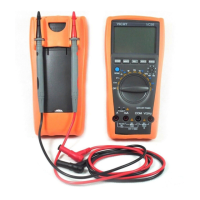
Do you have a question about the Vichy VC99 3 6/7 DMM and is the answer not in the manual?
| Duty Cycle | 0.1% to 99.9% |
|---|---|
| Temperature | -20°C to 1000°C |
| Continuity | Yes |
| Diode Test | Yes |
| Operating Temperature | 0°C to 40°C |
| Power Supply | 9V battery |
| AC Voltage | 750V |
| DC Current | 10A |
| AC Current | 10A |
| Frequency | 10Hz |
| Display | 3 6/7 digits LCD, max. reading to 39999 |
Check test leads and avoid exceeding voltage limits (DC 1000V, AC 750V).
Exercise caution when measuring voltages above DC 60V or AC 40V.
Select correct function/range, move leads when switching functions, don't input voltage during current measurement.
Explanation of safety symbols such as high voltage, GND, and low battery.
Details on LCD display, measurement method, sampling rate, and environmental working conditions.
Core technical specifications including accuracy, input impedance, and overload protection for various measurement types.
Overview of the LCD display and function keys like HOLD, REL, Hz/DUTY, DC/AC, RANGE, MAX/MIN.
Steps for measuring DC voltage using the multimeter, including range selection and lead connection.
Procedure for measuring AC voltage, covering range selection and proper lead placement.
Guide to measuring DC current, including selecting the correct terminal and mode.
Instructions for measuring AC current, specifying terminal use and mode selection.
How to measure resistance, including using the REL function and precautions.
Steps for measuring capacitance, including lead connection, clearing readings, and discharge.
Procedure for measuring frequency using the Hz/DUTY key and test leads or shielded cable.
How to measure the hFE parameter of a transistor by inserting it into the correct socket.
Instructions for testing diodes (forward/backward) and checking continuity with the buzzer.
Guide to measuring temperature using the K type thermocouple and selecting Celsius or Fahrenheit.
How to use the HOLD key to freeze the displayed measurement value on the LCD.
Explanation of the automatic power-off function and how to cancel it.
Avoid inputting high voltage, using in extreme conditions, and improper cleaning.
Steps for replacing the battery and fuses, ensuring correct type and handling safety.
Solutions for common faults like no reading on LCD, big error values, or signal appearance.
